
Mediterranean Garden Society

Mediterranean Garden Society

Highlights from the AGM Three Fingers Tour, Spring 2025
by E. Kirsten Honeyman
Photographs by E. Kirsten Honeyman unless stated otherwise
Photographs to illustrate the article published in The Mediterranean Garden No. 121, July 2025
The photo at the top of this page shows mounds of yellow Euphorbia dendroides light up a path in the overcast landscape of Monemvasia’s Upper Town (Photo: Richard G. Turner)
Kirsten Honeyman reports on the AGM 2025 tour of the Peloponnese:
The Peloponnese
For the uninitiated, Greece conjures up images of the Acropolis in Athens or the blue-domed churches of the Cycladic islands. The Peloponnese is not typically the first thing that comes to mind. This is a decidedly good thing for travellers who don’t like to be elbow-to-elbow with masses of tourists. This region, separated from mainland Greece by the Isthmus of Corinth, has managed to retain its rural feel and slow pace of life. Small towns and villages dot the region and gorgeous countryside still abounds. For lovers of both history and mediterranean vegetation, it is a heavenly destination where impressive archaeological sites, both big and small, nonchalantly nestle into the stunning landscape as they have done for centuries or even millennia.
The MGS’s spring 2025 AGM, a tour of the southern Peloponnese, managed in one short week to give us a representative taste of what this part of Greece has to offer. Our tour, designed and led by the Peloponnese Branch Head Katerina Georgi, took us to charming seaside villages, centuries-old castles, Byzantine churches, and private gardens. We hiked through UNESCO World Heritage sites as well as along narrow, little-known trails. There was something for everyone, and daily hikes were a nice break from the coach travel necessary to see the region. Several of the locations we visited were outstanding destinations, and it is these experiences I would like to describe in this article.
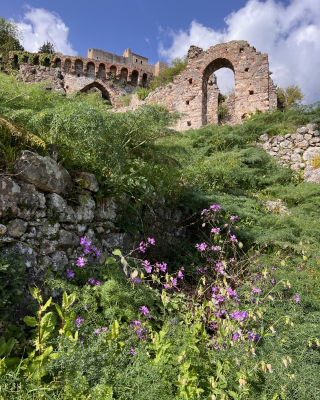
Mystras
Mystras, a UNESCO World Heritage Site. is an inland, fortified city situated in the foothills of the Taygetos mountains in the province of Laconia, not far from the town of Sparta. Built by the Franks, it later served as a provincial capital for the ruling Byzantine Empire in the 14th and 15th centuries. It was a prosperous community and a rich cultural centre. The city supported many artists and architects, and one can see the influence of Constantinople in the Palaiologan Renaissance art and Byzantine architecture of the numerous churches of Mystras. The 15th-century Greek scholar and philosopher Gemistos Plethon lived for the latter part of his life in Mystras. Indeed, many scholars settled here after the Fall of Constantinople to the Turks in 1453.

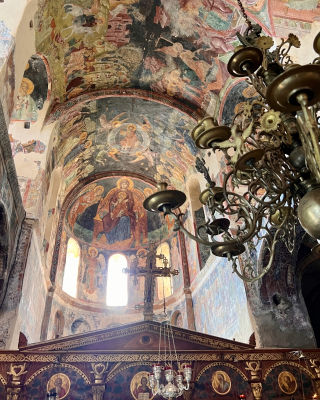
Anticipating that it would be fruitless to try to keep us together for a hike, Katerina turned us loose at the base of the Mystras complex. We broke into small groups and headed up a stone-paved main street that climbed steeply up the hill. It soon branched off in various directions on to footpaths. In early times, such narrow lanes and dirt paths were the standard routes on which people traversed the city. The steeply sloped hillside made it too difficult for wheeled carts, so walkers and beasts of burden would have been common on the trails.
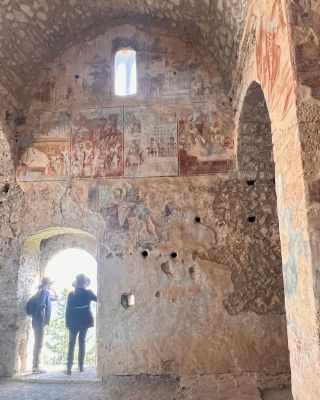
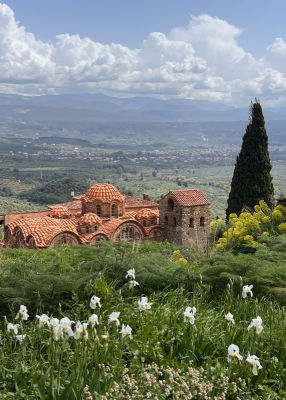
As we climbed upward, each taking a different path, fantastic views of sky, countryside, ruins, and flowers began to reveal themselves. In certain areas it was difficult to know what had existed before, as all that remained were crumbing walls and stairways to nowhere. Most of the religious structures, however, have been better maintained under the auspices of the Ministry of Culture, Education and Religious Affairs, responsible for restorations. During the Palaiologan Renaissance (the last phase of Byzantine art, from the mid-13th to the mid-15th centuries), the churches of Mystras were known not only as important religious sites, but as cultural centres as well. They were decorated with elaborate frescoes and were known for their sophisticated libraries. Some of the frescoes remain and are well-preserved, while others are derelict.
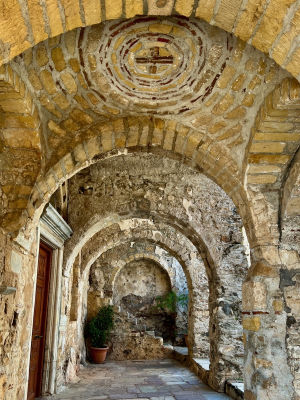
A few intrepid hikers made it all the way to the fortifications at the top of the site while most people spent time in the Upper and Middle City zones. Particularly impressive were the Pantanassa monastery and church (still inhabited by a small group of nuns); Hagia Sophia, or the church of the Holy Wisdom; the ruins of the church of St Nicholas; and the church of St Demetrios, with its distinctive red-tiled dome.
Wildflower species in bloom at Mystras included purple Lunaria annua (honesty) and pouch-shaped Silene vulgaris (bladder campon). Cupressus sempervirens, Ferula communis and Euphorbia characias were in abundance, as were naturalised Iris albicans (originally from Saudi Arabia and Yemen). In a nod to gardening, the nuns at Pantanassa have created a charming collection of Olea europaea bonsai, on display in their courtyard. All in all, our experience at Mystras was truly inspiring and checked all the boxes for our highest hopes for the tour.
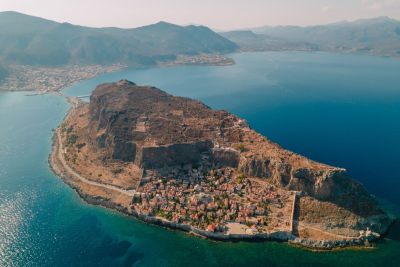
Monemvasia
The UNESCO World Heritage Site of Monemvasia sits on a stunning, land-tied island off the easternmost finger of the Peloponnese. The island’s name derives from the Greek words moni (single) and emvasis (approach), referring to the narrow spit connecting the island to the mainland. This defensible spit of land and the steep hillsides of the island made it a highly desirable location for settlement in early times when invasions and pirate raids were a constant threat. The island sits in the Myrtoan Sea where it enjoys mild winters and very hot summers (Csa in the Köppen climate classification).

In the 11th and 12th centuries, Monemvasia experienced significant economic growth due to its important role for the Byzantine Empire, guarding the western entrance to the Aegean. The population increased, and important structures were built. Reconstruction of the Hagia Sophia church and the church of Elkomenos Christos were undertaken during this period. The ruins one sees today largely date from this period of importance and success.
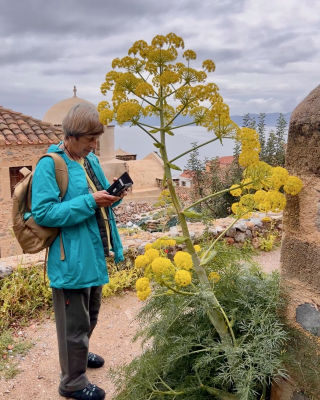
Katerina released us at the fortified gate to the Lower Town, and the tour group once again fanned out across the landscape, each person following his or her nose. There were slow botanisers among us and those gung-ho to hike to the fortress at the top. There was something for everyone, and the site did not disappoint.
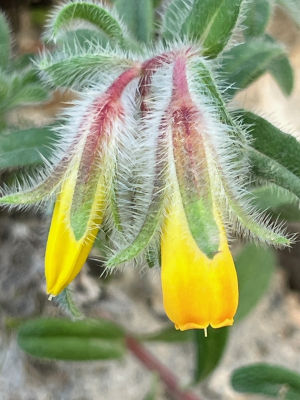
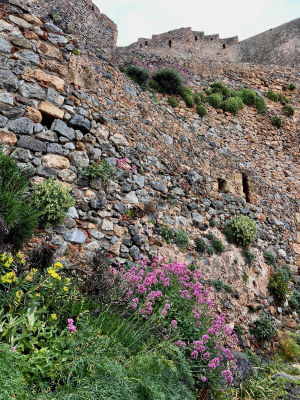
On the cliffs separating the Lower Town from the Upper Town, we were treated to purple mounds of Campanula topaliana clinging to the rocky walls.Bright pink Valeriana rubra (syn. Centranthus ruber) and yellow Phlomis fruticosa were also in abundance. Several botanisers sighted clumps of Onosma frutescens sporting narrow hairy leaves and yellow flowers.
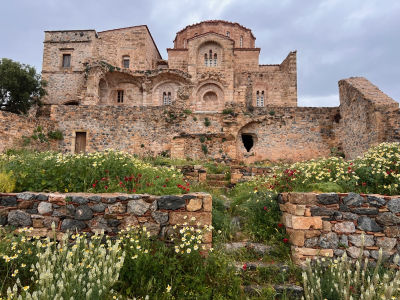
In the Upper Town, the Hagia Sophia church was awash with Glebionis coronaria (formerly Chrysanthemum coronarium), while spectacular stalks of Ferula communis (giant fennel) provided photographers with jaw-dropping vignettes of their bright yellow flowers against vistas of sea, ruins and Byzantine architecture.
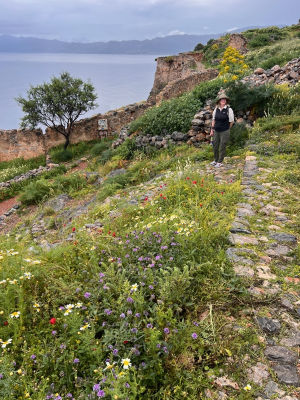
Tour member Kimberly Dougherty, standing near a stalk of Ferula communis,
takes in the clouds of Glebionis coronaria, Reseda alba, Papaver rhoeas, and purple Bituminaria bituminosa
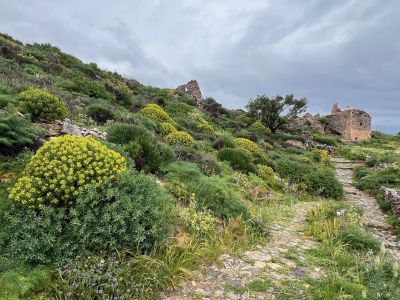
Mounds of yellow Euphorbia dendroides light up a path in the overcast landscape of Monemvasia’s Upper Town Photo – RGT
On the upper rocky trails, Mother Nature put on a master class as to how Euphorbia dendroides should be distributed across a hillside to create a composition of maximum beauty. It is safe to say that the overall experience of this magical place was a trip highlight and rated outstanding by tour participants.
A stellar private garden
After we’d stayed three nights in the lovely seaside village of Kardamyli, Katerina organised a hike into the seasonally lush hills above. The destination? Her own charming house and garden. The steady uphill climb took us past the fortified settlement of the Mourtzinos Clan and through olive groves backlit by the morning sun.
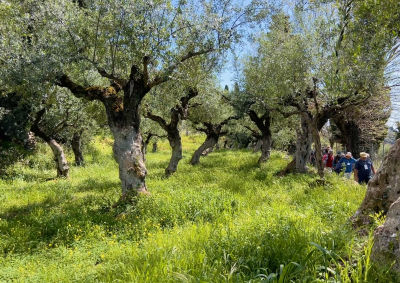
As the trail narrowed and steepened, the botanisers among us began to lag as they discovered wildflowers along the walk. Among the flowers spotted were Cyclamen rhodium ssp. peloponnesiacum, Cistus creticus, Orchis italica, Ptilostemon chamaepeuce and Umbilicus rupestris. We finally emerged from the woods at the site of a small Byzantine church not far from Katerina’s land.
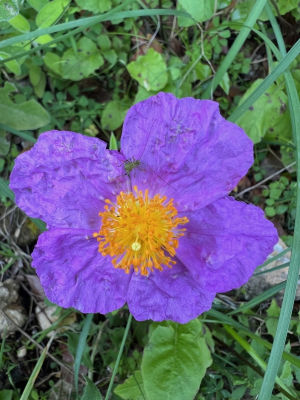
Cistus creticus on the trail to Katarina’s home (Photo: Richard G. Turner)
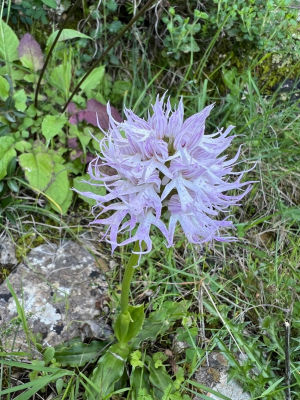
The lovely Orchis italica, or naked-man orchid (RGT)
Situated high above the sea at 200m (656ft), Katerina’s property enjoys a wonderful position, with views of the Taygetos mountain range in the distance and the Bay of Messinia below. When she purchased the property in 2009, the stone house was dilapidated and the garden essentially undeveloped.
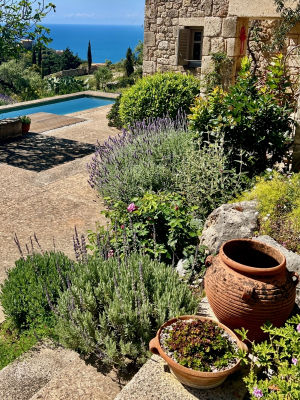
Katerina has done an exceptional job renovating the house and making it functional, while still retaining a sense of its humble Greek-village-house origins. This talent for understanding the deep story of a place and keeping it front and centre in her design choices was also evident in the garden. She has managed to create a landscape both natural and sophisticated that works seamlessly with the surrounding countryside. (Be sure to read Katerina’s witty account of developing her property in TMG 117, July 2024)
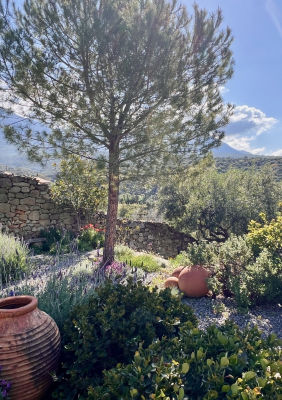
Terracotta balls and an antique olive jar sit among Lavandula, Festuca glauca, Cistus, and Euphorbia characias, creating a pleasing vignette under a backlit Pinus pinea
Katerina’s well thought-out landscape design can be broken down into a few important approaches: the hardscape and plantings are relatively formal near the house and become less so as the garden merges into the surrounding terrain; key plants are repeated to create a feeling of harmony; a serene colour palette favours drought-tolerant Mediterranean plants with leaves of subtle greens and greys (such as Phlomis, Salvia, Helichrysum, Teucrium and Artemisia); and the garden’s layout makes excellent use of the spectacular borrowed views.

View toward the Bay of Messinia with the stunning eco friendly pool, the garden blending into the surrounding landscape (RGT)

Tour members enjoying Katerina’s upper terrace, with its restrained palette of plants and fabulous borrowed views of the Taygetos mountain range (RGT)
It was particularly interesting to learn about Katerina’s swimming pool. It was built in 2014 on the upper terrace of the garden and may have been the first of its kind in Greece. It resembles a small conventional pool but has a natural filtration system. It uses no chemicals and never requires emptying. This makes it both waterwise and eco-friendly – valuable characteristics as we move forward in a climate-challenged environment.
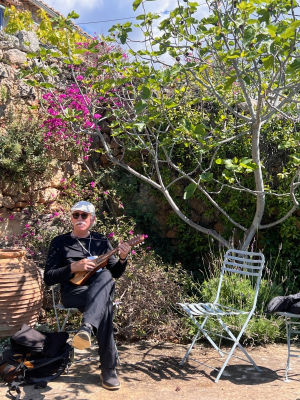
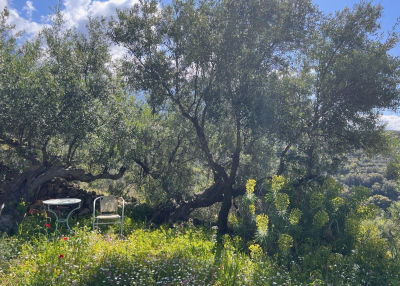
On the middle terrace, Olea europaea original to the garden, surrounded by a haze of Euphorbia characias, Papaver rhoeas, and Erigeron
We enjoyed our time wandering through the garden, identifying plants, and trying to commit the beauty of it all to our memories. Tour member Bruce Honeyman played background music during the event, making it even more festive and enjoyable.
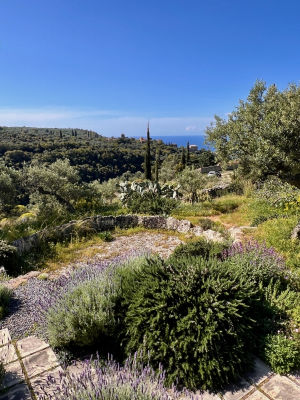
An old threshing floor, hewn out of solid rock and circled by Salvia Rosmarinus and Lavandula, adds beauty and historical significance to the lower garden

Interface between the garden and the surrounding countryside, with plantings of Ficus carica, Lavandula, and Opuntia
At the end of the visit, we gathered for a group photo, with everyone in strong agreement that this had been yet another outstanding event.
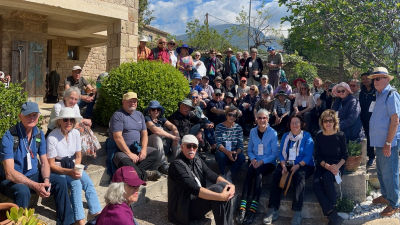
A talk by Olivier Filippi
French nurseryman Olivier Filippi has an enthusiastic following among mediterranean gardeners, so it was with great anticipation that we gathered at a meeting room in the old town to hear him present a lecture on “Gardening in a changing climate: New interactions between birds, insects and plants.” In addition to being an expert plantsman, Olivier has become quite knowledgeable about insects and birds and how they interact with plant species to pollinate them and spread their seeds. His message about the future was both stark and hopeful in equal measure.
The first part of the lecture was dedicated to the looming crisis of increasing global temperatures and drought. He used maps to illustrate how parts of the Mediterranean Basin are already recording temperatures significantly above their normal range as well as rainfall significantly below normal levels. Within a matter of decades, he predicts, some areas will become uninhabitable to plant species that naturally occur there now. While insects and birds have some capacity to adapt to new food sources or could possibly migrate further north, plants are going to need help from humans.
As Mediterranean zones experience increasing heat and dryness, we shall have to use plants more suited to these conditions in our gardens and public places. And plants that are now suited to the Mediterranean Basin will need help from humans to ‘migrate’ north. We shall need to proactively plant Quercus ilex, for example, in more northerly places than it is currently found. The rapidity with which global warming is occurring is simply too fast for such plant species to spread on their own.
Olivier’s message was dire, but he emphasised the resilience of the natural world and its capacity to adapt. He urged us to work with the coming crisis and seek out ways to be stewards for plant and animal species affected by the rapid changes. He reinforced the notion that gardeners have an extremely important role to play. The talk was excellent and his message quite powerful. Yes, you’ve guessed: it was once again, outstanding. It was a great send-off, capping a truly enjoyable tour. Kudos to Katerina for pulling it all off!
THE MEDITERRANEAN GARDEN is the registered trademark of The Mediterranean Garden Society in the European Union, Australia, and the United States of America
website designed and maintained
by Hereford Web Design